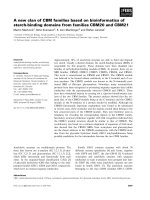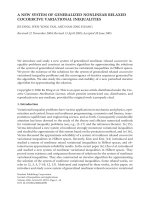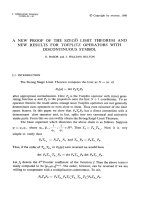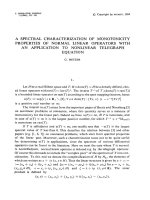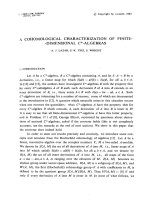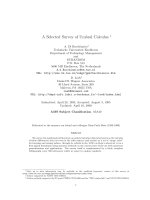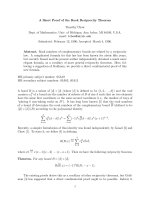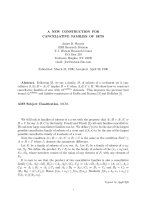Báo cáo toán học: "A New Table of Constant Weight Codes of Length Greater than 28." docx
Bạn đang xem bản rút gọn của tài liệu. Xem và tải ngay bản đầy đủ của tài liệu tại đây (118.82 KB, 18 trang )
A New Table of Constant Weight Codes of Length
Greater than 28
D. H. Smith, L. A. Hughes and S. Perkins
Division of Mathematics and Statistics
University of Glamorgan, Pontypridd, CF37 1DL, Wales, UK
{dhsmith,lahughe1,sperkins}@glam.ac.uk
Submitted: Feb 3, 2006; Accepted: May 1, 2006; Published: May 12, 2006
Mathematics Subject Classification: 94B60
Abstract
Existing tables of constant weight codes are mainly confined to codes of length
n ≤ 28. This paper presents tables of codes of lengths 29 ≤ n ≤ 63. The mo-
tivation for creating these tables was their application to the generation of good
sets of frequency hopping lists in radio networks. The complete generation of all
relevant cases by a small number of algorithms is augmented in individual cases by
miscellaneous constructions. These sometimes give a larger number of codewords
than the algorithms.
1 Introduction
A(n, d, w) is the maximum possible number of binary vectors of length n,weightw and
pairwise Hamming distance no less than d [10]. Such a set of vectors is known as a constant
weight code and the vectors are referred to as codewords. Tables of constant weight codes
are given in [6] for n ≤ 28. These tables are extended to n ≤ 65 and sometimes above
in [13], but the results are very sparse for larger values of n. Improved results for upper
bounds are given in [2] and corresponding tables for n ≤ 28 can be found at [14].
In this paper tables of constant weight codes are given for 29 ≤ n ≤ 63. The motivation
for this work was the generation of frequency hopping lists for use in assignment problems
in radio networks. Large distance between codewords gives smaller overlap between lists.
This leads to fewer clashes on the same frequency and so less interference. Similarly, a
larger number of codewords allows larger list re-use distances in the network and again
leads to lower interference. More information on the work can be found in [12] and an
evaluation of assignments of the lists generated can be found in [11]. The tables given here
are significantly more complete than those given in [12] and include many improvements.
The restriction n ≤ 63 was selected as 63 is the maximum number of frequencies
possible in GSM mobile telephone systems when frequency hopping is used. The range
the electronic journal of combinat orics 13 (2006), #A2 1
3 ≤ w ≤ 8 was selected for the work described in [12] as lists of length 2 are known
to give no advantages when hopping and the maximum gains from frequency diversity
(mitigating frequency selective fading) and interference diversity (averaging interference
to ensure that the error-control coding is effective) are achieved when w = 8. Disjoint
lists lead to unsatisfactorily small list re-use distances, so the cases d =2w − 2(overlap
1), d =2w − 4(overlap2)andd =2w − 6 (overlap 3) were considered. However, the
tables in [13] are complete for w =3andw =4whenn ≤ 63, so the tables for these
values (which were included in [12]) will not be presented here.
Within these ranges it was required that a constant weight code could be generated
with a large number of codewords (without necessarily achieving A(n, d, w)) in all cases,
using either (i) one of only a small number of algorithms suitable for Engineering ap-
plication (ii) individual mathematical constructions which give further increases in the
number of codewords in specific cases. Thus the tables allow a general comparison of the
merits of the chosen algorithms. They also demonstrate further improvements by detailed
constructions in some individual cases.
Let(q
1
,q
2
,n
1
,n
2
,d) denote a mixed error-correcting code, of length n = n
1
+ n
2
,where
the first n
1
entries of any codeword take values from 0 to q
1
− 1, the next n
2
entries take
values from 0 to q
2
− 1, and the minimal Hamming distance between different codewords
is no less than d. In one of the construction methods in Section 2.2 the following simple
result is used:
Proposition 1 Suppose that C is a (q
1
,q
2
,n
1
,n
2
,d) code. Then there exists a constant
weight binary code
C with |C| words of length
n = q
1
n
1
+ q
2
n
2
, minimum distance 2d,
and weight w = n
1
+ n
2
. This code is constructed in the following way: take each word
X =[x
1
x
2
x
n
] of the initial (q
1
,q
2
,n
1
,n
2
,d) code and substitute each x
i
in it by a row
of q
1
entries if i ≤ n
1
and by a row of q
2
entries if i>n
1
. Of those entries (numbering
the entries starting from 1) the entry with number x
i
+1 is equal to 1 and all other entries
are 0.
2 Constructions
In this section the constructions used to create the tables are described:
2.1 Construction from permutation groups
This construction of codes from a permutation group G generated by a single permutation
is taken from [6]. Initially all orbits of G are determined, starting from orbits of codewords
of weight 1. Consider a complete set of binary vectors of length n and weight i,eachof
which is a lexicographically maximal representative of its orbit. Suppose also that these
are arranged in decreasing lexicographic order. From each vector, new vectors of weight
i + 1 are generated by converting a single 0 to a 1 in all possible ways. For each vector
generated, determine whether it is lexicographically maximal over its orbit. If it is, record
the vector, otherwise discard it.
the electronic journal of combinat orics 13 (2006), #A2 2
For t = w − d/2 + 1, a matrix B withcolumnsindexedbyorbitsofweightw and with
rows indexed by orbits of weight t can be formed. B specifies how often a representative
vector of weight t is covered by the vectors in a given orbit of weight w. Orbits of weight
w for which the corresponding row of B contains an entry greater than 1 can be discarded
(as two elements of the constant weight code will have overlap greater than w − d/2).
The remaining orbits of weight w are represented by the vertices of a weighted graph,
with the vertex labelled by the number of codewords in the set. Two vertices are joined
if the pair does not conflict with the minimum distance condition. A maximum clique
algorithm is then used to find the maximum weighted clique in this graph which, from
the orbits represented by its vertices, gives the maximum constant weight code for this G.
Cyclic cases (with the permutation a cycle of length n), extended cyclic cases (with
the permutation a cycle of length n − 1) and (for n =2s) quasi-cyclic cases (with a
permutation (1 2 s)(s +1 2s)) were considered. For 29 ≤ n ≤ 63 these provided
a challenging set of computations. The maximum clique software used was based on the
algorithm in [7]. The computation could fail for reasons of either memory or run time. In
some cases (marked *) only an incomplete clique search was possible. Sometimes these
incomplete searches gave new best results. A poor result from an incomplete search is a
reflection of the infeasibility of the algorithm rather than its ineffectiveness. If the clique
search will not terminate it is often useful to apply the maximum clique algorithm with
several different orderings by vertex degrees. This sometimes leads to a larger clique being
found quickly. Sometimes a clique of size 1 or 2 gives a good result and the maximum
clique algorithm is unnecessary.
Cyclic cases are denoted CC in the tables; extended cyclic cases are denoted EC in
the tables and quasi-cyclic cases are denoted QC in the tables.
2.2 Lexicographic search for mixed or non-binary codes
In this method parameters for a suitable non-binary or mixed code (so that n = n
1
q
1
or
n = n
1
q
1
+n
2
q
2
) are determined and a lexicographic search [9] for such a code is performed.
The code found by the search which has the maximum number of codewords is then used
in Proposition 1. Results are given in the columns marked NB − Mix. Constant weight
codes constructed by this method cannot be expected to be particularly good; in just four
cases this method gave the best result. However, the method is easily the fastest of those
used (finding an example for every case 9 ≤ n ≤ 63 in a single run of under 24 hours on
a 400MHz Pentium PC with 128Mb of memory). In the frequency hopping application it
may prove useful that the 1’s in the codewords constructed appear once in every q
1
or q
2
consecutive positions.
2.3 Binary lexicographic search
Several variations of binary lexicographic search [9] are possible. Here binary vectors of
length n and weight w are arranged in either forward or reverse lexicographic order. A
single vector is used as a seed vector and the other vectors are selected in turn and added
the electronic journal of combinat orics 13 (2006), #A2 3
to the code if they satisfy the necessary distance condition. This search is usually faster
than the permutation group construction, but may take over a day of computation in the
largest cases. However, it always proved possible to complete both the forward and the
reverse search. The better of the two results is given in the tables in the column marked
B − Lex, and annotated (R)ifitisobtainedbyreversesearch.
2.4 Random search
If the run time for lexicographic search is unsatisfactory, codes can be constructed ran-
domly. Words of weight w are chosen randomly and tested to see whether they meet the
required distance condition with previously chosen codewords. If they do, they are added
to the code. The ultimate number of codewords selected is smaller but more codewords
can be obtained in a limited search. No results are presented as they are almost always
much worse than binary lexicographic search.
2.5 Miscellaneous constructions
Miscellaneous constructions of four types were considered and lead to codes as follows:
• codes with 29 ≤ n ≤ 63 constructed by application of some method described in [6],
• other codes taken from [13] where a construction is given,
• other codes taken from the literature,
• codes constructed by the authors.
In all cases the method is indicated in the Key. All methods in [6] were considered when
attempting to construct a new best code. Of course it was impossible to be comprehensive
in selecting a permutation group or code to be the basis of some of these constructions.
3 A table of constant weight codes
The results are given in Tables 1– 12. The tables also display the Johnson upper bound
[6] (in the column marked UB in the tables). The reader is referred to [2] for possible
improvements to this bound. The best result is indicated in bold in the tables. The
column NewBest indicates a new best result. The meaning of the annotations is given in
the Key.
The tables show the relative merits of the general algorithms in terms of the number of
codewords generated, with the permutation group construction being generally the best
of the algorithms used, followed by binary lexicographic search. Non-binary or mixed
lexicographic search is certainly the fastest method, but binary lexicographic search will
generally be preferred if the permutation group construction is too slow.
the electronic journal of combinat orics 13 (2006), #A2 4
KEY
• A
n
– From a code above (or from [6]) of length n.
• B – Using A(65, 8, 8) = 65520 [15], equation 5(ii) of [6] gives A(64, 8, 8) = 57456.
Comment. A(64, 8, 8) = 57456, A(65, 8, 8) = 65520. The code realising
A(65, 8, 8) = 65520 consists of two orbits of length 32760 under PSL
2
(64). Taken
from [13].
• BE – via Baker’s elliptic semi-plane, a {7}-GDD of type 3
15
, [4], p.191 [8], [13].
Comment. A(45, 12, 7) = 45. Given a partition of the 45 points into 15 groups
of size 3 then in the GDD two of the 45 points are either in a (single) block (of 7
points) or in a single group, but not both. Thus the overlap is at most 1. Counting
we have
45
2
= b.
7
2
+13.
3
2
so b = 45. Taken from [13].
• C – Theorem 1 of [3].
Comment. A(33, 8, 5) = 44, A(34, 8, 5) = 47.
• D – Construction I from [1].
Comment. A(55, 8, 5) = 121, A(42, 8, 6) = 343. In the first case p = 11, n =5,
k = 2 and in the second case p =7,n =6,k =3.
• EH – Words of weight 5 in a translate of the (32, 26) Extended Hamming Code,
using a vector of weight 1.
Comment. A(32, 4, 5) = 6293.
• Eq. x –Equationx of [6].
• H
n
– Adding words to a code above (or from [6]) of length n.
• M – Manual construction.
• NB – Construct the code realising A
5
(8, 7) = 10 [5] and apply Proposition 1.
Comment. A(40, 14, 8) = 44.
• P – Words of weight 6 in the Preparata code of length 64.
• R – Reverse binary lexicographic search.
• Th. y –Theoremy of [6].
• S–Completinga(28, 4, 1) RBIBD (p. 90, [8]) gives a partially balanced design
with 63 blocks of size 5 and one of size 9. This last block can be replaced by two
blocks of size 5, p90 [8], [13].
Comment. A(37, 8, 5) = 65. A parallel class of a (28, 4, 1) design consists of 7
blocks forming a partition of the 28 points. The 63 blocks form 9 parallel classes.
Add a point 29 to each block of the first parallel class, 30 to each block of the
second, 37 to each block of the ninth. Finally, add two extra blocks 29,30,31,32,33
and 33,34,35,36,37. Taken from [13].
• SS – A Steiner system.
• * – Clique search was incomplete.
the electronic journal of combinat orics 13 (2006), #A2 5
n CC, EC, QC NB − Mix B − Lex Misc UB NewBest
29 3770, *3591, – 816 3731 (R) 4095 (Eq. 31) 4750
30 976 4459 (R) 4751 (Eq. 31) 5262
31 1136 5313 (R) 5481 (Eq. 31) 6274
32 1324 6293 (R) 6293 (EH) 6944
33 1544 6503 7192 (Eq. 31) 8184
34 1801 7051 8184 (Eq. 31) 8976
35 2101 7159 9276 (Eq. 31) 10472
36 2401 7881 10472 (Eq. 31) 11397
37 2744 8353 (R) 11781 (Eq. 31) 13186
38 3136 9259 13209 (Eq. 31) 14341
39 3584 10168 14763 (Eq. 31) 16450
40 4096 11334 16451 (Eq. 31) 17784
41 4096 12598 18278 (Eq. 31) 20254
42 4160 14156 20254 (Eq. 31) 21781
43 4288 15831 22386 (Eq. 5(ii)) 24647
44 4481 17635 25256 (Eq. 5(ii)) 26488
45 4741 19657 28413 (Eq. 5(ii)) 29799
46 5001 21940 31878 (Eq. 5(ii)) 31878
47 5328 24488 35673 (SS) 35673
48 5724 27273 (R) 35674 (Th. 18) 38006
49 6192 30348 (R) 38916 (Eq. 31) 42336
50 6736 33667 42376 (Eq. 31) 45080
51 7280 37092 (R) 46060 (Eq. 31) 49980
52 7900 40928 (R) 49980 (Eq. 31) 53040
53 8600 45101 (R) 54145 (Eq. 31) 58565
54 9385 49633 (R) 58565 (Eq. 31) 61959
55 10000 54547 (R) 63251 (Eq. 31) 68156
56 10000 59867 (R) 68211 (Eq. 31) 72072
57 10000 65618 (R) 73458 (Eq. 31) 79002
58 10000 71722 (R) 79002 (Eq. 31) 83311
59 10000 78302 (R) 84854 (Eq. 31) 91025
60 10000 85386 (R) 91026 (Eq. 31) 95748
61 10000 93003 (R) 97527 (Eq. 31) 104310
62 10000 101123 (R) 104371 (Eq. 31) 109678
63 10000 109833 (R) 111569 (Eq. 31) 119133
Table 1: Comparison of Results d =4,w =5.
the electronic journal of combinat orics 13 (2006), #A2 6
n CC, EC, QC NB − Mix B − Lex Misc UB NewBest
29 290,*287,– 100 244 365 Y
30 306,*319,*315 112 271 (R) 390 Y
31 341,*366,– 127 311 (R) 415 Y
32 384,*403,*384 137 340 492 Y
33 429,*424,– 150 379 (R) 528 Y
34 476,*495,*459 162 413 557 Y
35 532,*510,– 182 456 (R) 651 Y
36 576,*567,*504 202 496 691 Y
37 629,*621,– 219 542 732 Y
38 684,*666,– 200 591 (R) 843 Y
39 741,*722,– 224 638 889 Y
40 256 694 (R) 741 (A
39
) 936 Y
41 288 755 (R) 1066 Y
42 288 817 1117 Y
43 321 874 1169 Y
44 346 941 (R) 1320 Y
45 372 1009 1386 Y
46 405 1097 (R) 1444 Y
47 430 1172 1616 Y
48 464 1254 (R) 1689 Y
49 504 1343 (R) 1764 Y
50 532 1429 1960 Y
51 619 1517 (R) 2040 Y
52 668 1617 2121 Y
53 731 1719 2342 Y
54 776 1822 2430 Y
55 824 1924 (R) 1936 (Eq. 5(ii)) 2519
56 736 2036 2125 (Eq. 5(ii)) 2766
57 674 2162 2329 (Eq. 5(ii)) 2872
58 576 2280 (R) 2548 (Eq. 5(ii)) 2969
59 576 2397 2783 (Eq. 5(ii)) 3245
60 576 2531 3036 (Eq. 5(ii)) 3360
61 898 2665 3306 (Eq. 5(ii)) 3477
62 1017 2801 (R) 3596 (Eq. 5(ii)) 3782
63 1122 2952 (R) 3906 (Eq. 5(i)P) 3906
Table 2: Comparison of Results d =6,w =5.
the electronic journal of combinat orics 13 (2006), #A2 7
n CC, EC, QC NB − Mix B − Lex Misc UB NewBest
29 899,*882,– 226 853 (R) 1170 (A
27
) 1459
30 265 1005 (R) 1179 (H
27
) 1825 Y
31 303 1163 (R) 1205 (H
27
) 2015 Y
32 353 1331 (R) 2213
33 412 1528 (R) 2706 Y
34 468 1740 2992 Y
35 538 1973 (R) 3249 Y
36 618 2240 3906 Y
37 676 2539 (R) 4261 Y
38 762 2836 (R) 4636 Y
39 842 3167 5479 Y
40 944 3545 5926 Y
41 1049 3964 6396 Y
42 1175 4397 7462 Y
43 1284 4860 8005 Y
44 1402 5378 8572 Y
45 1368 5933 (R) 9900 Y
46 1568 6521 10626 Y
47 1792 7160 (R) 11311 Y
48 2048 7845 12928 Y
49 2190 8568 13793 Y
50 2366 9348 (R) 14700 Y
51 2577 10175 16660 Y
52 2807 11064 11316 (Eq. 5(ii)) 17680
53 3055 12025 12760 (Eq. 5(ii)) 18735
54 3346 13017 (R) 14355 (Eq. 5(ii)) 21078
55 3605 14091 16112 (Eq. 5(ii)) 22275
56 3881 15221 (R) 18045 (Eq. 5(ii)) 23510
57 4210 16422 20167 (Eq. 5(ii)) 26277
58 4532 17683 22493 (Eq. 5(ii)) 27762
59 4854 19028 (R) 25039 (Eq. 5(ii)) 29195
60 5258 20431 27821 (Eq. 5(ii)) 32450
61 5638 21940 30856 (Eq. 5(ii)) 34160
62 6026 23493 34162 (Eq. 5(ii)) 35929
63 6473 25185 (R) 37758 (Eq. 5(ii)P) 39711
Table 3: Comparison of Results d =6,w =6.
the electronic journal of combinat orics 13 (2006), #A2 8
n CC, EC, QC NB − Mix B − Lex Misc UB NewBest
29 29, 35, – 18 27 40 Y
30 36, 29, 36 18 29 42
31 31, 36, – 20 32 43
32 32, 31, 32 23 34 38 (Eq. 5(ii)) 44
33 33, 40, – 24 36 44 (C) 52
34 34, 33, 34 25 38 47 (C) 54
35 42, 34, – 27 41 50 (Eq. 5(ii)) 56
36 36, 42, 54 31 44 57 (Eq. 5(ii)) 57
37 37, 45, – 31 47 65 (S) 66
38 38, 37, 57 32 50 65 (A
37
) 68
39 39, 38, – 32 52 65 (A
37
) 70
40 48, 39, 64 32 57 72 (Eq. 5(ii)) 72
41 82, 58, – 32 60 82 (SS) 82
42 42, 82, *63 33 62 84
43 86, 42, – 35 67 86
44 88, 86, *88 33 68 88
45 54, 55, – 33 73 99 (SS) 99
46 92, 54, *92 36 76 99 (A
45
) 101
47 94, 92, – 40 80 99 (A
45
) 103
48 96, 94, *96 40 81 99 (A
45
) 105
49 98, 108, – 46 85 117 Y
50 110, 98, *80 46 89 120
51 102, 110, – 52 91 122
52 104, 102, *54 54 96 110 (A
51
) 124
53 106, 117, – 57 100 137
54 108, *106, *54 65 105 117 (A
53
) 140
55 110, *108, – 68 107 121 (D) 143
56 112, *121, – 65 112 145
57 114, *70, – 60 117 129 (Eq. 5(ii)) 159
58 116, *114, – 56 119 141 (Eq. 5(ii)) 162
59 118, *116, – 48 123 154 (Eq. 5(ii)) 165
60 120, *118, – 48 122 168 (Eq. 5(ii)) 168
61 61, *75, – 56 131 183 (SS) 183
62 *124, *122, – 63 136 183 (A
61
) 186
63 *126, *124, – 71 137 183 (A
61
) 189
Table 4: Comparison of Results d =8,w =5.
the electronic journal of combinat orics 13 (2006), #A2 9
n CC, EC, QC NB − Mix B − Lex Misc UB NewBest
29 116, 112, – 65 99 130 (A
26
) 159
30 125, 116, *105 67 115 (R) 131 (H
26
) 200 Y
31 155, 155, – 69 125 (R) 156 (Eq. 5(ii)) 217 Y
32 192, 155, *104 73 131 (R) 229 Y
33 –, 160, – 76 139 (R) 192 (A
32
) 242 Y
34 76 152 (R) 192 (A
32
) 294 Y
35 80 168 192 (A
32
) 315 Y
36 88 184 (R) 193 (H
32
) 336
37 95 199 351
38 109 222 418
39 118 244 (R) 442
40 128 275 (R) 466
41 137 285 (R) 294 (Eq. 5(ii)) 492
42 147 307 343 (D) 574
43 160 332 343 (H
42
) 602
44 164 355 (R) 630
45 178 381 660 Y
46 200 411 (R) 759
47 224 440 (R) 791 Y
48 256 477 (R) 824 Y
49 256 501 857 Y
50 264 542 975 Y
51 253 576 1020 Y
52 271 609 (R) 1057 Y
53 289 650 1095 Y
54 314 682 1233 Y
55 334 729 1283 Y
56 347 766 1334 Y
57 376 830 1377 Y
58 402 872 1537 Y
59 420 935 1593 Y
60 446 982 1650 Y
61 471 1028 1708 Y
62 505 1079 1891 Y
63 531 1143 1953 Y
Table 5: Comparison of Results d =8,w =6.
the electronic journal of combinat orics 13 (2006), #A2 10
n CC, EC, QC NB − Mix B − Lex Misc UB NewBest
29 319, 308, – 64 300 617 Y
30 76 327 (R) 681
31 86 363 885 Y
32 104 403 (R) 992
33 122 444 1079 Y
34 150 498 1175 Y
35 165 555 (R) 1470
36 187 622 (R) 1620
37 214 696 1776
38 241 785 (R) 1905
39 278 869 (R) 2328
40 310 977 2525 Y
41 350 1095 (R) 2729
42 390 1206 (R) 2952
43 425 1347 3526 Y
44 474 1478 3784 Y
45 522 1639 4050 Y
46 578 1795 4337
47 631 1987 5096 Y
48 699 2173 (R) 5424 Y
49 766 2376 5768 Y
50 835 2603 (R) 6121 Y
51 896 2839 7103 Y
52 970 3101 7577 Y
53 1072 3376 (R) 8003 Y
54 1376 3651 (R) 8447 Y
55 1792 3941 (R) 9687 Y
56 2048 4270 10264 Y
57 2048 4625 10862 Y
58 1557 4971 (R) 11409 Y
59 1675 5384 (R) 12954 Y
60 1780 5770 13654 Y
61 1910 6223 (R) 14378 Y
62 2078 6693 15128 Y
63 2227 7171 7182 (Eq. 5(i)B) 17019
Table 6: Comparison of Results d =8,w =7.
the electronic journal of combinat orics 13 (2006), #A2 11
n CC, EC, QC NB − Mix B − Lex Misc UB NewBest
29 0, 0, – 12 15 20 (Eq. 5(ii)) 24
30 5, 0, 15 13 17 (R) 25 (Eq. 5(ii)) 25
31 31, 11, – 14 19 31 (SS) 31
32 0, 31, 16 15 23 31 (A
31
) 32
33 0, 0, – 17 23 31 (A
31
) 33
34 0, 0, 17 19 26 31 (A
31
) 34
35 35, 0, – 22 26 35
36 36, 35, 36 22 27 42 Y
37 37, 36, – 22 30 43 Y
38 38, 37, 38 25 31 44 Y
39 39, 38, – 26 32 45 Y
40 40, 39, 40 28 35 46 Y
41 41, 40, – 31 34 42 (Eq. 5(ii)) 54 Y
42 49, 41, 49 32 38 56 Y
43 43, 49, – 34 39 57 Y
44 44, 43, *44 29 43 49 (A
43
) 58 Y
45 45, 44, – 31 44 49 (A
43
) 60 Y
46 46, 54,23 33 46 69 Y
47 47, 46, – 32 48 56 (Th. 21) 70
48 56, 47, 24 32 47 72
49 49, 56, – 36 50 73
50 50, 49, 25 32 50 56 (A
49
) 75
51 51, 60, – 36 55 85 Y
52 52, 51, 26 40 59 60 (A
51
) 86 Y
53 53, 52, – 45 63 88 Y
54 63, 53, – 48 65 90 Y
55 55, 63, – 49 68 91 Y
56 56, 66, – 48 70 102 Y
57 57, 56, – 52 69 70 (A
56
) 104 Y
58 58, 57, – 58 72 106 Y
59 59, 58, – 60 77 108 Y
60 70, 59, – 62 79 110 Y
61 61, 72, – 65 83 122 Y
62 62, 61, – 67 84 124 Y
63 126, 62, – 71 85 126 Y
Table 7: Comparison of Results d =10,w =6.
the electronic journal of combinat orics 13 (2006), #A2 12
n CC, EC, QC NB − Mix B − Lex Misc UB NewBest
29 29, 32, – 22 34 37 (Eq. 5(ii)) 95 Y
30 30, 29, *45 25 38 (R) 48 (Eq. 5(ii)) 102 Y
31 62, 35, – 28 43 110 Y
32 32, 62, *32 30 47 141 Y
33 66, 32, – 34 54 150 Y
34 68, 66, *34 36 60 (R) 160 Y
35 75, 68, – 39 66 170 Y
36 72, *75, *36 44 75 180 Y
37 *74, *78, – 46 83 91 (Eq. 5(ii)) 222 Y
38 –, *111, – 53 92 (R) 233 Y
39 –, *114, – 57 102 (R) 245 Y
40 –, *117, – 64 113 (R) 257 Y
41 68 126 269 Y
42 72 133 (R) 324 Y
43 79 142 155 (Eq. 5(ii)) 344
44 83 155 (R) 184 (Eq. 5(ii)) 358
45 90 169 (R) 217 (Eq. 5(ii)) 372
46 94 181 (R) 255 (Eq. 5(ii)) 394
47 105 191 (R) 299 (Eq. 5(ii)) 463
48 112 209 (R) 350 (Th. 21) 480
49 118 224 350 (A
48
) 504
50 126 241 (R) 350 (A
48
) 521
51 137 255 350 (A
48
) 546
52 146 272 350 (A
48
) 631
53 154 287 350 (A
48
) 651
54 192 308 (R) 351 (Th. 21) 678
55 224 327 (R) 351 (A
54
) 707
56 256 348 (R) 351 (A
54
) 728
57 196 366 (R) 830 Y
58 210 394 (R) 861 Y
59 220 414 (R) 893 Y
60 237 431 925 Y
61 251 458 958 Y
62 266 486 1080 Y
63 277 514 1116 Y
Table 8: Comparison of Results d =10,w =7.
the electronic journal of combinat orics 13 (2006), #A2 13
n CC, EC, QC NB − Mix B − Lex Misc UB NewBest
29 87, *84, – 28 75 (R) 319 Y
30 90, *87, *45 36 89 (R) 92 (Eq. 5(ii)) 356 Y
31 124, *90, – 48 104 395 Y
32 64 119 124 (A
31
) 440 Y
33 64 134 581 Y
34 69 156 637 Y
35 78 176 (R) 700 Y
36 86 198 (R) 765 Y
37 98 223 832 Y
38 109 249 1054 Y
39 123 285 1135 Y
40 136 318 (R) 1225 Y
41 150 353 1317 Y
42 168 390 1412 Y
43 179 432 (R) 1741 Y
44 198 484 (R) 1892 Y
45 218 532 2013 Y
46 242 590 2139 Y
47 268 642 (R) 2314 Y
48 294 711 (R) 2778 Y
49 312 776 (R) 2940 Y
50 338 852 3150 Y
51 370 929 (R) 3321 Y
52 391 1007 (R) 3549 Y
53 433 1095 (R) 4180 Y
54 469 1194 (R) 4394 Y
55 508 1289 4661 Y
56 544 1405 4949 Y
57 579 1517 5187 Y
58 631 1633 6017 Y
59 672 1767 6349 Y
60 724 1908 6697 Y
61 792 2043 7053 Y
62 992 2189 (R) 7424 Y
63 1024 2352 8505 Y
Table 9: Comparison of Results d =10,w =8.
the electronic journal of combinat orics 13 (2006), #A2 14
n CC, EC, QC NB − Mix B − Lex Misc UB NewBest
29 0, 4, – 4 5 8 (M) 16 Y
30 0, 0, 0 5 6 8 (A
29
) 17 Y
31 0, 5, – 7 6 9 (M) 22
32 0, 0, 0 8 9 22
33 0, 0, – 10 623Y
34 0, 0, 0 5 8 12 (Eq. 5(ii)) 24
35 5, 0, – 5 11 15 (Eq. 14) 25
36 0, 5, 0 9 12 15 (A
35
) 25
37 0, 6, – 11 15 16 (Eq. 5(ii)) 31 Y
38 0, 0, 19 13 12 32 Y
39 0, 0, – 17 18 19 (A
38
) 33 Y
40 0, 0, 20 14 18 34 Y
41 0, 0, – 12 24 (R) 35 Y
42 6, 0, 24 12 22 27 (Eq. 5(ii)) 36
43 0, 13, – 18 19 32 (Eq. 5(ii)) 43
44 0, 0, 22 19 27 38 (Eq. 5(ii)) 44
45 0, 0, – 21 28 45 (BE) 45
46 0, 0, 23 19 30 45 (A
45
) 46
47 0, 0, – 23 31 45 (A
45
) 47
48 48,0,48 25 33 (R) 48
49 49, 56, – 25 36 (R) 56 (SS) 56
50 50, 49, 50 27 35 56 (A
49
) 57
51 51, 50, – 28 38 (R) 56 (A
49
) 58
52 52, 51, 52 31 40 (R) 56 (A
49
) 59
53 53, 52, – 33 40 (R) 56 (A
49
) 60
54 54, 53, 54 34 43 56 (A
49
) 61
55 55, 54, – 32 44 57 (H
49
) 70
56 56, 55, 56 32 47 (R) 57 (A
55
) 72
57 57, 56, – 32 48 (R) 73
58 58, 57, 58 34 47 74 Y
59 59, 58, – 32 51 75 Y
60 60, 59, 60 36 53 77 Y
61 61, 70, – 40 54 (R) 87 Y
62 62, 61, 62 33 55 64 (Eq. 5(ii)) 88 Y
63 72, 62, – 33 57 90 Y
Table 10: Comparison of Results d =12,w =7.
the electronic journal of combinat orics 13 (2006), #A2 15
n CC, EC, QC NB − Mix B − Lex Misc UB NewBest
29 0, 14, – 12 16 22 (Eq. 5(ii)) 58
30 15, 0, 30 12 17 60 Y
31 31, 15, – 12 21 (R) 65 Y
32 32, 31, 32 16 23 88 Y
33 33, 32, – 16 24 (R) 90 Y
34 34, 33, *34 18 28 (R) 97 Y
35 35, 34, – 22 31 105 Y
36 36, 40, *36 24 36 112 Y
37 37, 36, – 27 38 (R) 40 (A
36
) 115 Y
38 38, 37, *38 26 39 40 (A
36
) 147 Y
39 39, 38, – 29 46 (R) 48 (Eq. 5(ii)) 156 Y
40 60, 39, *40 33 50 (R) 165 Y
41 35 53 64 (Eq. 5(ii)) 174
42 37 58 79 (Eq. 5(ii)) 183
43 40 64 (R) 96 (Eq. 5(ii)) 193
44 44 66 117 (Eq. 5(ii)) 236
45 47 72 142 (Eq. 5(ii)) 247
46 52 78 171 (Eq. 5(ii)) 258
47 56 85 205 (Eq. 5(ii)) 270
48 58 91 (R) 246 (Eq. 5(ii)) 282
49 61 99 (R) 294 (Eq. 5(ii)) 294
50 65 105 350 (SS) 350
51 71 114 350 (A
50
) 363
52 74 122 (R) 350 (A
50
) 377
53 81 131 350 (A
50
) 390
54 85 141 (R) 350 (A
50
) 405
55 91 152 (R) 350 (A
50
) 419
56 95 160 (R) 351 (H
50
) 490
57 99 168 351 (A
56
) 513
58 106 178 351 (A
56
) 529
59 110 193 351 (A
56
) 545
60 118 204 (R) 352 (H
56
) 562
61 123 216 (R) 352 (A
60
) 587
62 200 226 352 (A
60
) 674
63 224 244 352 (A
60
) 693
Table 11: Comparison of Results d =12,w =8.
the electronic journal of combinat orics 13 (2006), #A2 16
n CC, EC, QC NB − Mix B − Lex Misc UB NewBest
29 0, 4,– 44 14
30 0, 0, 0 4 4 5 (M) 15
31 0, 0, – 4 5 15
32 4, 0, 4 4 5 16
33 0, 4, – 4 5 6 (M) 16
34 0, 0, 0 4 5 6 (A
33
) 17
35 0, 0, – 5 5 7 (M) 17
36 0, 5, 0 5 6 9 (M) 22
37 0, 0, – 6 6 9 (A
36
) 23
38 0, 0, 0 6 6 9 (A
36
) 23
39 0, 0, – 5 6 9 (A
36
) 24
40 0, 0, 5 5 6 10 (NB) 25
41 0, 5, – 5 7 10 (A
40
) 25
42 0, 0, 0 6 7 10 (A
40
) 26
43 0, 6, – 8 10 32
44 0, 0, 0 9 12 33 Y
45 0, 0, – 12 733Y
46 0, 0, 0 13 934Y
47 0, 0, – 6 12 15 (Eq. 5(ii)) 35
48 6, 0, 6 6 14 (R) 18 (Eq. 5(ii)) 36
49 0, 6, – 11 15 21 (Eq. 5(ii)) 36
50 0, 7, 0 14 19 25 (Eq. 14) 43
51 0, 0, – 15 14 25 (A
50
) 44
52 0, 0, 26 18 21 27 (Eq. 5(ii)) 45
53 0, 0, – 19 22 31 (Eq. 5(ii)) 46
54 0, 0, 27 18 25 36 (Eq. 5(ii)) 47
55 0, 0, – 15 27 (R) 42 (Eq. 5(ii)) 48
56 7, 0, 28 15 28 49 (Eq. 5(ii)) 49
57 57, 15, – 24 23 57 (SS) 57
58 0, 57,29 23 33 58
59 0, 0, – 25 33 57 (A
58
) 59
60 0, 0, 30 25 35 (R) 57 (A
58
) 60
61 0, 0, – 27 37 (R) 57 (A
58
) 61
62 0, 0, 31 28 37 (R) 58 (H
58
) 62
63 63, 0, – 56 41 (R) 63
Table 12: Comparison of Results d =14,w =8.
the electronic journal of combinat orics 13 (2006), #A2 17
References
[1]N.Q.A,L.Gy¨orfi and J.L. Massey. Constructions of binary constant-weight cyclic
codes and cyclically permutable codes. IEEE Trans. Inform. Theory, vol. 38, (1992),
940–949.
[2] E. Agrell, A. Vardy, and K. Zeger. Upper bounds for constant-weight codes. IEEE
Trans. on Inform. Theory, vol. 46, no. 7 (2000), 2373-2395.
[3] H.K. Aw, Y.M. Chee and A.C.H. Ling. Six new constant weight binary codes. Ars
Combinatoria, vol. 67, (2003), 313–318.
[4] R.D. Baker. An elliptic semiplane. J. Combinatorial Theory A, vol. 25, (1978), 193–
195.
[5] G.T. Bogdanova and P.R.J.
¨
Osterg
◦
a
rd. Bounds on Codes over an Alphabet of Five
Elements. Discrete Mathematics, vol. 240/1-3, (2001) 13–19.
[6] A.E. Brouwer, J.B. Shearer, N.J.A. Sloane and W.D. Smith. A new table of constant
weight codes. IEEE Trans. Inform. Theory, vol. 36, no. 6, (1990), 1334–1380.
[7] R. Carraghan and P.M. Pardalos. An exact algorithm for the maximum clique prob-
lem. Operations Research Letters, 9(1990) 375–382.
[8] C.J. Colbourn and J.H. Dinitz. The CRC handbook of combinatorial designs.Boca
Raton, Florida, CRC Press, 1996.
[9] J.H. Conway and N.J.A. Sloane. Lexicographic codes; error-correcting codes from
game theory. IEEE Trans. Inform. Theory, vol. 32,(1986), 337–348.
[10] F.J. MacWilliams and N.J.A. Sloane. The theory of error-correcting codes. Amster-
dam, The Netherlands, North-Holland, 1977.
[11] J.N.J. Moon, L.A. Hughes and D.H. Smith. Assignment of frequency lists in frequency
hopping networks. IEEE Trans. on Vehicular Technology, vol. 54, no. 3, (2005), 1147-
1159.
[12] D.H. Smith, A. Sakhnovich, S. Perkins, D.G. Knight and L.A. Hughes.
Application of coding theory to the design of frequency hopping lists.
Technical Report UG–M–02–1, University of Glamorgan, 2002. Available at
/>[13] Table of constant weight binary codes.
/>[14] Table of bounds for constant weight binary codes.
/>[15] />the electronic journal of combinat orics 13 (2006), #A2 18
